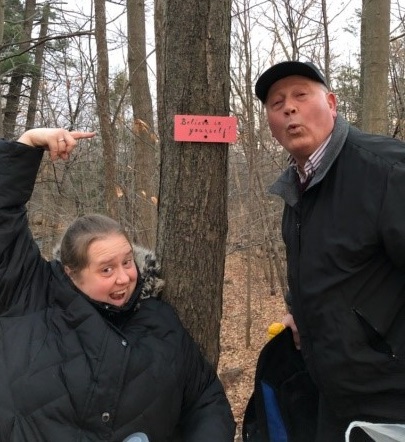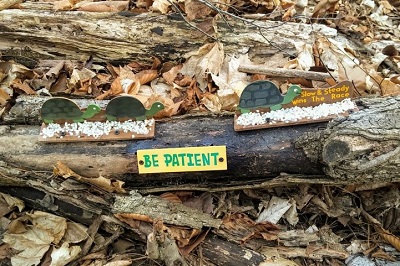Menu
Close
The Enchanted Forest
Feb 3, 2021
Where the Refreshing Benefits of Nature Meet the Nurturing Words of a CYC
Guest post by Kathryn Small, CYC (Child and Youth Care)
Hello! And welcome to the Enchanted Forest- “The Most Magical Place on Earth!” No, wait… that’s Disney World… Welcome to the Enchanted Forest- “Where Dreams Come True!” Wait, that’s still Disney, isn’t it? Um… Oh, I know! Welcome to the Enchanted Forest- “It’s Amazing in Here!” What?! Canada’s Wonderland? I really thought I had it that time!
Well, welcome to the enchanted forest. It doesn’t need a slogan, it speaks for itself. Come run the trails or take a leisurely stroll. Listen to the trickling water in the stream; soak in the vitamin D as you feel those warm rays of sunshine caress your face. Wander on your own, or bring the kids, there’s something here for everyone! Oh, and while you’re in here- make sure you keep your eyes peeled!
Hi, my name is Kathryn, and I want to tell you all about a very cool project that’s been going on in our community. Near my home, there are some beautiful trails through the ravine, and right now, with all the COVID restrictions, there’s really not a whole lot of things to do, (especially for people who are trying to keep children, youth and teenagers entertained all day long without drop-in’s or play groups or regular extra-curricular activities), so going for a walk is a great option, and what a way to make it more fun!
The original idea came from an area in Bronte Creek Provincial Park, where my sister had taken my 2 young nieces one day. They discovered a path called “The Gnome Trail”, which follows the idea of painting rocks and leaving them on the ground for people to see, but this is taking it to a whole new level. The gnome trail was an immediate hit, the girls loved it. Especially the one who is 3 years old, she was completely taken by the “fairy tale theatre”, the miniature “fairy cottages” and other buildings that were set up along the path. She loved it so much, that she came home and excitedly told me about it, and my reply was “What a great idea- we should do that here!”
I went out to the dollar store and bought some little wooden houses, animal figures and trees. I brought them home and painted/decorated them and then took them out to the ravine near my house. I knew there would be certain youth and adolescents who would walk through and be tempted to break things, so my dad helped me actually screw or nail most of the things right into the wood.
There was still some damage done, one little house, in particular, was knocked over and broken. We were able to find all the pieces, so I brought them home and glued it back together with a 2×4 inside so it would be stronger, but after putting it back out there, it was broken again. It looks like someone just kicked it off the log it was on. I brought the pieces home again, and as I was trying to think of a way to make it even stronger and less damageable, I started thinking about who was knocking it over.
This made me want to know why, and in turn, how I could discourage it. I decided that rather than steering attention away from things, maybe I could add things that might just draw attention in a bit of a different direction, and at the same time, maybe I could inspire or encourage some of the older youth and teenagers out there.
Think back to child/adolescent development, and Erik Erikson’s 8 stages of psychosocial development… Stage 5: Identity vs. Role Confusion is supposed to cover the teenage years, so approximately ages 12-18. I’m going to go out on a limb and say that the person/people responsible for damaging parts of the enchanted forest are most likely within that age group.
Erikson says that these youth are at a point where they need to develop a sense of self and personal identity. They’re beginning to think more about moral, philosophical, ethical, social, and political issues (VeryWellMind, 2020) and form an opinion on where they will stand on these issues. They’re trying to decide on their personal beliefs, ideals and values, which will shape their futures and mold the adults they’re going to become (VeryWellMind, 2020). Those youth who are given encouragement and receive positive reinforcement will get through this stage (VeryWellMind, 2020) relatively unscathed, with a sense of independence, self-control and resilience.
So, how could I give inspiration and encouragement when I wasn’t even sure who these people were? I knew that they walked through this path, so I made some signs with short, positive messages on them, and put them up throughout the ravine. The signs say things like “You are worth it!”, “Inhale the good, Exhale the bad” and “Believe in Yourself!”
My dad, the hardware mastermind, helped me put them up… (story continues below)

I also made 2 bigger signs for the start and end of that section of trail. Each one says “Sherwood’s Enchanted Forest This Way” with an arrow pointing in the right direction.
Since the signs have been up, we’ve been pretty lucky! I haven’t seen anything that’s been destroyed, except for a few small weather related things that were an easy fix. Other people have also started to catch on to the idea! Someone went through and hung Christmas balls on branches all throughout, and there have been some other decorations that we’ve seen pop up in various places- a couple of snowmen, and some fancy, blue and white icicle candy canes. I love that it’s becoming a project for the entire community and that so many people can walk through and enjoy it.
I’m sure I don’t need to sell you on the benefits of spending time in nature, whether you’re actively exercising, like running or biking, or taking a leisurely stroll. Maybe you’re a writer, and you get your best inspiration just sitting quietly beside the stream amidst the rocks and trees and animals with a pen and a journal. I believe the term that’s being used right now is ecotherapy. And now, if you pick the right path, at the right time, there may just be some added benefits in the form of some beautiful decorations or some helpful messages that you happen to read at just the right moment.
And remember, all those health benefits from being outdoors also work on children, youth and adolescents! Walk with them and let them point out the things they spot on their way by! Items can become discussion pieces that lead to a deeper discussion. Or if they’re old enough, create a scavenger hunt where they take pictures of the things they’ve found. Better yet, let them add to the decorations! Dollarama is still open, and Michael’s does curbside pickups. Choose something already made or get creative and design it yourself! Believe me when I tell you that even if you don’t actually hear anyone saying it out loud- people will thank you for it! And I will too! (story continues below)

* For those of you who are worried about the environment, please note that I have been choosing natural, biodegradable pieces of wood and using a water based, non-toxic paint. At the beginning, yes, I screwed some things into trees, but have since made it a point to only put screws and nails into dead stumps or already fallen logs so that I’m not putting holes into anything living.
** I would like to thank whoever started the gnome trail in Bronte Creek which inspired me to start this project and also a big thank you to Julie Jaglowitz who taught my ‘Creative Therapeutic Programming’ class in the 2nd year of the CYC program at Sheridan College. Julie, you are more inspiring than you know.
Thank you to my mom, who has helped me so much with her artistic expertise and helping get things ready, and my dad for helping secure things to stumps and logs all while trying to preserve the artistic details and keep them intact.
An extra special, huge thank you to my 2 beautiful nieces who inspire me everyday with their curiosity and wonder and motivate me to try and make this world a better place.
References
VeryWellMind. (2020, June 26). Erik Erikson’s Stages of Psychosocial Development. Retrieved January 17, 2021, from verywellmind: https://www.verywellmind.com/erik-eriksons-stages-of-psychosocial-development-2795740
VeryWellMind. (2020, March 31). The 4 Stages of Cognitive Development: Background and Key Concepts of Piaget’s Theory. Retrieved January 17, 2021, from Very Well Mind: https://www.verywellmind.com/piagets-stages-of-cognitive-development-2795457